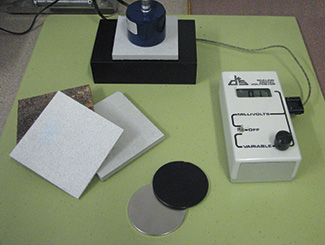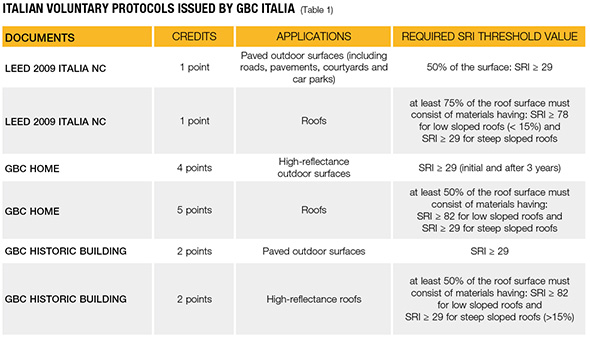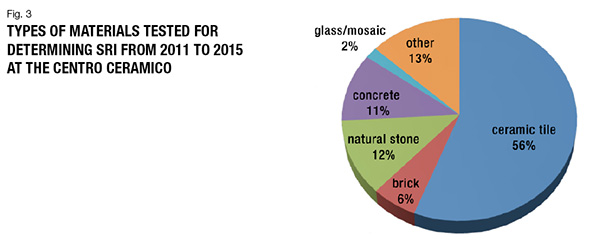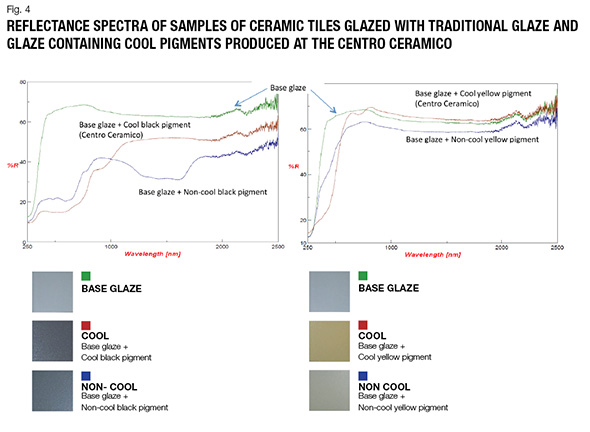 by Barbara Mazzanti - Centro Ceramico (Italy)29
Marzo
2016
by Barbara Mazzanti - Centro Ceramico (Italy)29
Marzo
2016
The Solar Reflectance Index and the role of ceramic tiles
The urban heat island effect is defined as an increase in air temperature (a 1-2°C rise in maximum daily values) in urban areas compared to surrounding rural areas due to human activities and housing. This effect also gives rise to a 10-15% increase in thunderstorm activity and a 20-30% decrease in wind.
There are various ways of mitigating the impact of urban heat islands, one of which is the use of reflecting materials. Reflecting materials, also known as cool materials, have a high reflectance of solar radiation (capacity to reflect incident radiation in the UV, visible and near-IR spectral ranges) and a high coefficient of thermal emittance (capacity to re-emit radiation in the IR spectral range). Low absorption of solar radiation and high infrared emission are factors that lower the surface temperature of materials, thereby reducing the quantity of heat emitted into the atmosphere. These surface properties of material are both taken into account in the calculation of Solar Reflectance Index (SRI), as defined by the standard ASTM E 1980-11.
Solar Reflectance Index in the main international certification protocols
Under Site Sustainability (Credits 7.1 and 7.2), LEEDŽ (Leadership in Energy and Environmental Design) certification establishes SRI thresholds for exterior surfaces and roofs, which are stricter for low sloped roofs:
- Exterior surfaces (pavements, car parks, etc.): SRI ≥ 29
- Low sloped roof: SRI ≥ 78
- Steep sloped roof: SRI ≥ 29
The ESTIDAMA protocol, adopted in the UAE, prescribes a rating system (Pearl System) in which the SRI is set at 29 for all surfaces of external structural elements. In HK BEAM PLUS certification, the protocol in force in Hong Kong, the “Microclimate around Buildings” Site Aspect (SA) stipulates the use of paving materials with a high albedo (at least 0.4) and roofing materials with SRI ≥ 78 that cover at least 50% of the total roof area.
The situation in Italy: voluntary environmental protocols and existing legislation
Although some international certifications have been adapted for use at an international level, there has been a tendency to develop national systems that take account of specific cultural and environmental factors and the local building tradition. In Italy, the ITACA protocol and Casaclima Nature certification (mandatory in the province of Bolzano) are rooted in local practices and until now have supported the regional system for promoting sustainable construction.
The Green Building Council (GBC) Italia has played an important role in importing LEED certification and adapting it to the Italian context, and has received American approval. The GBC has developed three new documents specifically for the Italian situation and the country’s architectural heritage, which specify that SRI (Table 1) should also be evaluated 3 years after installation..

By way of DM 24/12/2015, the Ministry for the Environment, Land and Sea has established the “Adoption of minimal environmental criteria (CAM) for the awarding of design services and new construction, renovation and maintenance work on buildings for management of construction sites of the public administration and minimal environmental criteria for the supply of incontinence aids”, thus aligning itself with environmental protection strategies adopted at an international level. Section 2.2.3 on “Reduction of impact on the microclimate and atmospheric pollution” establishes the requirement of materials with a high solar reflection index as specified below:
- for exterior surfaces (e.g. pavements, car parks, public squares, etc.): SRI ≥ 29.
- for roofs: SRI ≥ 29 for roofs with slope greater than 15% and SRI ≥ 75 for roofs with slope less than or equal to 15%.
Ceramic tiles and SRI
Ceramic tiles are often proposed in tenders as materials with high solar reflectance for the purpose of obtaining credits for heat island mitigation. It is important to know the material’s SRI in order participate in the tender with a product that meets the requirements of applicable legislation and to be able to choose products based on a comparison between their performance characteristics.
The SRI is determined by measuring the sample’s reflectance spectrum over an interval that covers 99% of solar radiation incident on the earth’s surface (280 - 2500 nm) in accordance with ASTM E 903-96 and by determining the thermal emittance value of the material’s surface in accordance with ASTM C 1371-04. The reflectance spectrum is then weighted with a standard solar spectrum (ASTM G173-03) to obtain the sample’s solar reflectance spectrum in accordance with ASTM E 903-96. This latter spectrum is used to obtain the coefficient of solar reflectance (or reflection) which appears in the formula for calculating the SRI (Figure 1).

From its own experience, the Centro Ceramico has observed that the number of requested tests has doubled over the last 2 years (Figure 3) in line with growing awareness of environmental issues and the shift from simple voluntary protocols towards legally binding regulations. Interestingly, while various types of materials have been tested, ceramic tiles make up 56% of the total (Figure 3). This indicates that the tile industry is increasingly looking to expand its fields of application for exterior surfaces and is proposing its products as an excellent alternative to traditional materials (concrete, glass, natural stone).

Ceramic tiles offer various advantages in terms of meeting the SRI thresholds, including:
- a high value of thermal emittance (0.80 – 0.95)
- colour brightness (the colorimetric coordinate L* and the SRI have a correlation coefficient of 0.72).
Furthermore, the excellent durability of ceramic tiles together with the fact that they maintain their colour characteristics when exposed to light means that high SRI values are maintained over time. The Centro Ceramico has been conducting research for several years into the use of cool pigments and high-reflectance transparent films to further improve the characteristics of tiles (Figure 4).
